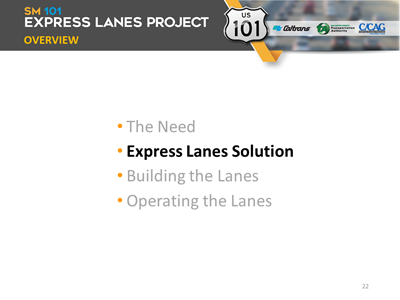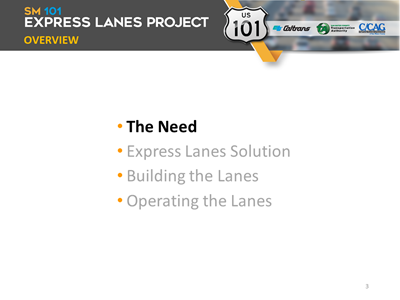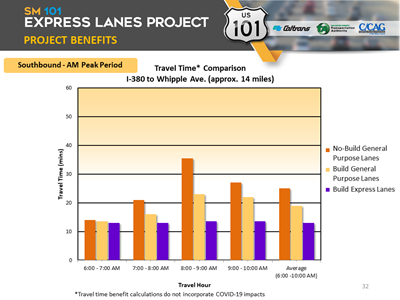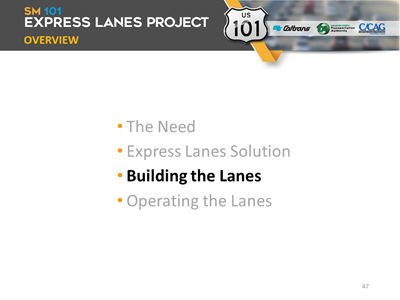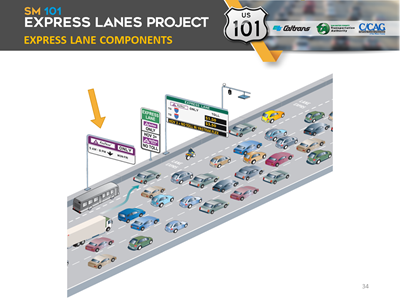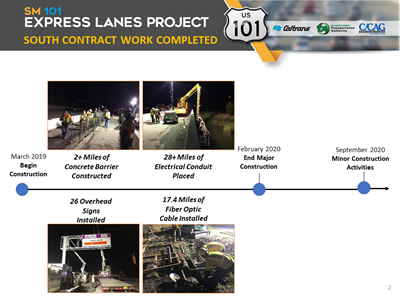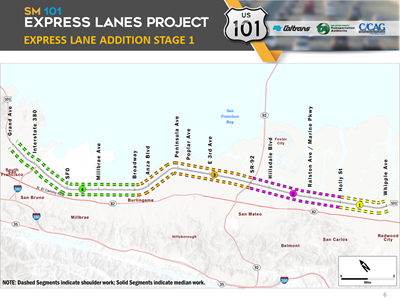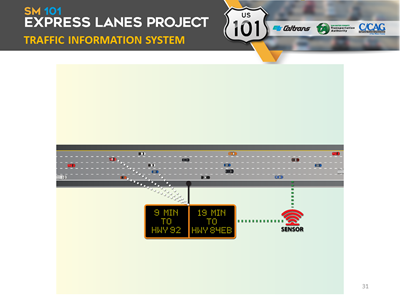101 Express Lanes FAQ
Project Design/General Questions
1. What is the San Mateo 101 Express Lanes Project?
2. How do express lanes help address congestion?
3. Why was the Project built in San Mateo County?
4. How can the express lanes improve my commute on U.S. 101?
5. How can the Project benefit transit users?
6. Did this Project take away a lane on U.S. 101?
7. Is there a shoulder to pull over on now that the lanes are constructed?
8. Are the freeway lanes narrower than before?
9. Did the freeway require new signs and equipment for the express lanes?
10. Why didn't we just build a carpool lane?
11. How do the express lanes in San Mateo County connect to the ones in Santa Clara County? Do I have to pay twice?
12. How was the Project funded?
13. Why doesn’t this Project extend all the way to the San Francisco County Line?
14. How long did it take to build?
15. What happened during Phase One of the Project?
16. What happened during Phase Two of the Project?
17. What kind of construction impacts did the Project have?
18. How did the Project notify travelers about project-related delays on U.S. 101?
19. How did the Coronavirus Pandemic affect Project construction?
20. Who is responsible for deciding operations policy?
21. What if there is an accident and the only open lane is the express lane?
22. Did this project fix the pavement?
23. What is the pattern on the median barrier?
1. What is the San Mateo 101 Express Lanes Project?
The San Mateo 101 Express Lanes Project was a multi-year, multi-agency project initiated to reduce traffic congestion and encourage carpooling and transit use on U.S. 101 in San Mateo County. The Project created 22 miles of express lanes in each direction on U.S. 101 from the San Mateo County/Santa Clara County Line to I-380 in South San Francisco. The San Mateo Express Lanes seamlessly connect to the express lanes in Santa Clara County. With the completed project, drivers have the option to drive in an express lane from the southern end of Sunnyvale to the San Francisco airport.
2. How do express lanes help address congestion?
Express lanes are High Occupancy Vehicle (HOV), or carpool lanes, with the option for non-carpoolers to pay a toll to use the lanes when space is available. Non-carpoolers, such as solo drivers, have the option to pay to use the express lanes, while maintaining speeds of 45 miles an hour or higher. This increases the speeds in the general-purpose lanes because some drivers will move out of them and into the express lanes. In an express lane, vehicles travel faster than in the general-purpose lanes. This provides an incentive for solo drivers to switch to a carpool or bus, an outcome that improves travel and air quality. This is why San Mateo County leaders decided an express lane was the right way to address traffic on U.S. 101.
3. Why was the Project built in San Mateo County?
Industries along the U.S. 101 corridor, the major commute route between San Francisco and Silicon Valley, make up a large percentage of California’s annual gross domestic product. This booming economy has fueled revenue and job growth, but it has also created overcrowding on U.S. 101. The San Mateo 101 Express Lanes Project created 22 miles of express lanes in each direction between the San Mateo County/Santa Clara County Line and I-380 in South San Francisco, improving traffic conditions and travel times for motorists on the corridor.
Click image below to watch a video on the need for the Project!
4. How can the express lanes improve my commute on U.S. 101?
Based on data gathered and analyzed for the San Mateo 101 Express Lanes Project, implementing an express lane on the U.S. 101 corridor offered the most significant travel time savings to drivers when compared to other alternatives considered, such as building a new general-purpose lane or not implementing an express lane. Drivers can experience the greatest travel time savings during the AM peak period (6:00 AM to 10:00 AM) and PM peak period (3:00 PM to 7:00 PM). For example, for a typical driver traveling in the southbound direction between 8:00 AM and 9:00 AM, where no express lane is implemented, their travel time could be as high as 35 minutes. If we had built an additional general-purpose lane to provide more capacity, that same driver could have a travel time of approximately 22 minutes. However, by implementing an express lane and that same driver opted to take a carpool or pay to use the express lane, they could travel the corridor in just over 12 minutes, saving more than 20 minutes of travel time.
Click image below to watch a video on how express lanes will benefit drivers on U.S. 101!
5. How will the Project benefit transit users?
Express lanes improve travel time and reliability of bus service by minimizing the delays caused by sitting in traffic. SamTrans (the San Mateo County bus service) is planning multiple express bus routes which will have priority in the express lanes.
6. Did this Project take away a lane on U.S. 101?
The number of general-purpose lanes stayed the same. Through extensive study, engineers determined they could fit an express lane in each direction by connecting auxiliary lanes on U.S. 101 to create an additional general-purpose lane and convert the left-most general-purpose lane into an express lane. This resulted in one new express lane in either direction along with the general-purpose lanes.
Click image below to watch a video on how the express lanes are being built!
7. Is there a shoulder to pull over on now that the lanes have been constructed?
There is still enough space on the shoulders in both the northbound and southbound directions for vehicles needing to make an emergency stop. There are a few locations where the shoulders are too narrow for vehicles to pull over, but these segments were designed to be short and infrequent spans.
8. Are the new lanes narrower than before?
The lane widths vary along the corridor, and in many places, the outside lanes are wider than the inner lanes. However, all lanes on the freeway are wide enough to accommodate all vehicles. After a thorough safety review, Caltrans engineers have determined that the Express Lanes meet Caltrans safety and operating standards.
9. Did the freeway require new signs and equipment for the express lanes?
Like a carpool lane that has special components – striping, pavement markings, and signs – the express lanes in San Mateo County also have special striping, pavement markings, and signs. Unlike some other express lanes, drivers can get in and out of the San Mateo 101 Express Lanes at any point. For the entire length of the express lanes constructed on this project, there are 8” wide skip strips, which are broken white skip pavement markings, indicating that the lane can be accessed or exited at any point. The words “EXPRS LANE” are painted in the lanes to indicate their special status. Signs indicating which hours of the day the tolling is in effect, what types of vehicles can use the express lane, and the cost to drive in the express lanes are also in use.
Click image below to watch a video on the different express lane components!
10. Why didn’t we just build a carpool lane?
Caltrans traffic engineers studied a variety of options to determine the most effective way to improve traffic conditions on the U.S. 101 corridor in San Mateo County. They found that with the number of vehicles with two or more people (2+ carpool) driving on the corridor, a 2+ carpool lane would fill up quickly and be congested. This would eliminate the benefits for transit riders and 2+ carpoolers. However, the traffic analysis projected that a lane for vehicles with three or more people (3+ carpool) would accommodate the existing 3+ carpoolers and contain extra space, which 2+ carpools and solo drivers could then fill. Combining a 3+ carpool lane with dynamic pricing for other vehicles (single occupancy, dual occupancy, and clean air vehicles) allows the express lane to maintain a consistent speed while also improving travel time in the general-purpose lanes. Therefore, express lanes proved to be the most effective way to improve traffic conditions on the U.S. 101 corridor in San Mateo County.
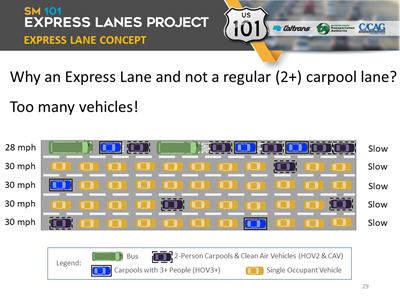
11. How do the express lanes in San Mateo County connect to the ones in Santa Clara County? Do I have to pay twice?
The San Mateo 101 Express Lanes seamlessly connect to the express lanes being constructed in Santa Clara County. Express lanes on U.S. 101 from State Route 237 in Sunnyvale to the Santa Clara County Line in Palo Alto are expected to open to traffic in late 2021. Tolls are based on zones within the corridor and paid using FasTrak® Flex. Each zone is approximately 4-5 miles long and a specific toll price is assigned to travel in that zone. Tolls accumulate as you travel through multiple zones on a trip, regardless of which county you are driving in. Overhead message signs give drivers advance notice of a price to travel to a specific destination. Drivers in the express lane experience no difference as they travel from one county to another.
12. How was the Project funded?
The $581 million Project was funded through a combination of Federal, State, local, regional, and private contributions. With over $53 million pledged from the private sector, this is one of the largest public/private infrastructure partnerships in the history of the region. Additional funds included $9.5 million in federal funding and nearly $307 million in State funding.
13. Why doesn’t this Project extend all the way to the San Francisco County Line?
Caltrans is currently evaluating the impact of possibly extending the express lanes on U.S. 101 in the northbound and southbound directions between I-380 in South San Francisco and the San Mateo County/San Francisco County Line.
14. How long did it take to build?
Construction of the San Mateo 101 Express Lanes occurred in two phases. Phase One construction began in 2019 in Palo Alto, East Palo Alto, Menlo Park, and Redwood City. Phase Two construction in Redwood City, San Carlos, Belmont, Foster City, San Mateo, Burlingame, Millbrae, San Bruno, and South San Francisco, began in early 2020. All construction was completed in 2022 with the lanes fully opened in early 2023.
Click image below to watch a video on the sequence of construction!
15. What happened during Phase One of the Project?
During Phase One, the carpool lanes were converted to express lanes from the San Mateo County/Santa Clara County Line to Whipple Avenue in Redwood City and covers the cities of Palo Alto, East Palo Alto, Menlo Park, and Redwood City. Express lanes in this section opened in February 2022.
Click image below to watch a video on the complete work in Phase One of the Project!
16. What happened during Phase Two of the Project?
During Phase Two, the Project constructed new express lanes from Whipple Avenue to I-380 in South San Francisco and covered the cities of Redwood City, San Carlos, Belmont, Foster City, San Mateo, Burlingame, Millbrae, San Bruno, and South San Francisco. Phase Two work was split into two stages. During Stage One, construction crews worked primarily on the outside, or shoulders, of the freeway. During Stage Two, construction crews worked primarily in the middle, or the median, of the freeway.
Click the images below to watch a video on the work occurring during Stage One and Stage Two in the northern section of the Project!
17. What kind of construction impacts did the Project have?
The following types of construction impacts occurred:
• Nighttime lane closures on U.S. 101 throughout the corridor. Working at night minimized impacts on traffic during the day.
• Ramp closures and temporary detours to city streets.
• Temporary lane closures on city streets adjacent to the freeway (necessitating one-way traffic) in order to connect electrical components to nearby hook-ups.
• Temporary lane closures and work on city streets adjacent to the freeway in order to move and rebuild three sections of sound wall on Bayshore Boulevard in the City of San Mateo.
- Additional information can be found here.
- Para mayor información visite aquí.
- 更多详情请访问 这里
• Overnight full freeway closures in 2021 and 2022. These closures took place in only one location per direction at a time and had a detour plan in place.
Details regarding these activities were included in the project’s weekly construction updates sent out by the Caltrans Public Information Officer.
18. How did the Project notify travelers about project-related delays on U.S. 101?
Caltrans implemented a Traffic Advanced Warning System during construction to provide up to date information and improve safety in the corridor. This system alerted travelers to real-time traffic conditions via changeable electronic message signs placed within the construction zone on U.S. 101. The system used sensors to detect the speed and volume of traffic. The system warned travelers about slowdowns before they were visible, and the warning gave drivers extra time to react, which has been shown to reduce accidents and improve traffic flow.
Click image below to watch a video on the Traffic Advanced Warning System!
19. How did the Coronavirus Pandemic affect Project construction?
During the various stages of the Shelter-in-Place orders associated with COVID-19, Caltrans continued to perform infrastructure construction activities on the San Mateo 101 Express Lanes Project. During this time, Caltrans made use of extended nighttime lane closures and daytime working hours to increase construction efficiency. As orders were lifted and traffic volumes increased, project construction resumed its pre-pandemic work hours.
20. Who is responsible for deciding operations policy?
The San Mateo County Transportation Authority (SMCTA) and the City/County Association of Governments of San Mateo County (C/CAG) have formed the San Mateo County Express Lanes Joint Powers Authority (SMCEL- JPA) to manage the express lanes. The SMCEL- JPA is responsible for setting policies for operations of the express lanes. More information about the JPA and the express lane policies and operations can be found at 101ExpressLanes.org.
21. What if there is an accident and the only open lane is the express lane?
When there is an accident in the express lanes, California Highway Patrol (CHP) will be notified and called to the location of the accident. During the accident, CHP has complete control over the toll system. The lane will be opened or closed to various vehicles at CHP’s discretion depending on the circumstances of the accident. The overhead signs will be updated with the status of the lane open or closure. In addition, CHP can close the express lanes if necessary to respond to an accident in the other general-purpose lanes or any other highway emergency.
22. Did this project fix the pavement?
As part of project construction, several sections of the freeway were repaved then restriped. All lanes from Broadway in Burlingame to Grand Avenue in South San Francisco have been rehabilitated (a process of grinding down the existing pavement then iteratively adding new pavement) to improve ride quality and extend the life of the roadway. The final layer of pavement and new lines were completed in 2022. All lanes from Whipple Avenue in Redwood City to Broadway also received a final layer of pavement and new lines in 2022. This corrected roadway scarring as a result of the new lanes being constructed and existing lanes being resized on both northbound and southbound U.S. 101. Any potholes and other roadway damage that occurred during construction has been repaired. Damage occurring after construction is fixed by Caltrans Maintenance.
23. What is the pattern on the median barrier?
The design of this aesthetic patterning was inspired by the history of computing innovation in Silicon Valley and is meant to evoke images of punch cards. At the same time, it reflects the aspirations of the new express lanes and evokes a feeling of acceleration. The patterns appear to race forward along-side traffic, creating a sense of movement and speed. The pattern was created by Caltrans Landscape Architects and is named “Binary Hyperdrive”.
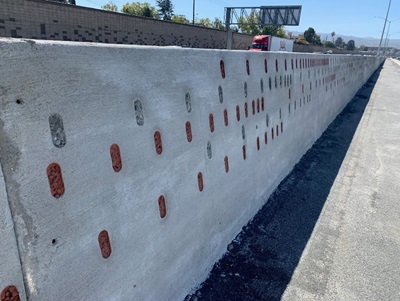
Binary Hyperdrive pattern on the newly reconstructed median barriers on U.S. 101 in San Mateo County


